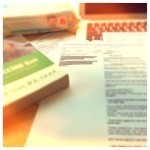 A new friend recently asked me about testing her child’s room for formaldehyde. She noticed that the newly-installed closet in her nursery had a strange order, and she wanted to make sure it was safe.
A new friend recently asked me about testing her child’s room for formaldehyde. She noticed that the newly-installed closet in her nursery had a strange order, and she wanted to make sure it was safe.
She sent me a link to a formaldehyde test she found on Amazon and asked for my opinion. Of course I’m not a formaldehyde expert, but I did cover the Lumber Liquidators formaldehyde floor fiasco pretty extensively and learned quite a bit about testing for the chemical. So, I started searching my records and found the link to the nonprofit we used to get free tests for the folks we featured in our stories. Though I told her, if it were me, I’d probably buy a few different tests just to be sure. (A byproduct of my career as a skeptical consumer reporter).
That got me thinking about the various resources I’ve found over the years to test for lead, concerning chemicals or flame retardants in products. Generally I find them while researching news stories and later use them myself at home. So, I’ve decided to start a running list that I’ll add to from time to time. If you’re looking for a specific test, reach out and ask me… I’ll investigate.
Here’s what we have so far:
Test Your Home for Formaldehyde
From flooring to furniture, many of the products in your home contain formaldehyde. High levels of formaldehyde have been linked to respiratory issues and other health concerns. This can be especially problematic for children with asthma.
There are several for-profit companies that sell formaldehyde tests. These can be found with a Google search.
There are also several tests for sale on Amazon that come with customer ratings to help you determine which might be best for your purposes.
In response to the 60 minutes investigation that exposed formaldehyde in Lumber Liquidator flooring, the nonprofit Global Community Monitor was providing tests for a small donation. It appears the testing program has expired, but you might be able to reach out to the group for additional resources.
Question: How do I test for Formaldehyde?
Answer: Generally these are air tests, so they test for the amount of total formaldehyde in a room. It may take a little sleuthing and trial and error to figure out where it is specifically coming from.
Test Your Foam for Flame Retardants
From the Environmental Working Group to the Ecology Center to the Green Science Policy Institute, a majority of the nonprofits who research chemical flame retardants use the lab at Duke University’s Nicholas School of the Environment.
Duke’s Superfund Research Center also tests consumer foam for free though funding by the National Institute of Environmental Health Sciences (NIEHS).
To have samples of your foam tested, simply log on HERE and follow the instructions. But keep in mind, they only test a limited number of samples each month. Your best bet is to check in on the first of the month to get a sample number for testing.
Duke does not provide results for the amount of a chemical in a sample, the lab simply provides a positive or negative for known flame retardants.
There are also a few private labs I’ve found that will test your foam for a fee. I can’t guarantee they will continue to test one-off consumer products, but in the past, both STAT Analysis and EMSL Analytical have agreed to test foam for consumers.
If a lab asks what method they should use to test, independent researchers have advised me that they use “EPA methods – EPA 8270C and EPA 3550C.” I have no idea what that means—I just provided that information to the labs.
Question: What products in my home may contain concerning flame retardants?
Answer: Anything with foam (i.e. crib mattress, bassinet pads, the couch, changing pad, breastfeeding pillow, etc.). All car seats contain flame retardants, but experts say some are more concerning than others.
For details, check out “Concerning Chemicals in Orbit Baby and Other Car Seats.”
Test Your Home and Water for Lead
In light of the heartbreaking story about lead in Michigan drinking water that may have irreparably sickened thousands of children, lead testing is top of mind for many parents. Research shows lead poisoning in children can and does cause brain damage and diminished mental and physical development.
If you live in a home built before 1978, odds are that you have layers of lead paint in your home. It’s not generally a significant concern until it begins to chip and flake and migrate into dust—especially around doors and window frames.
Of course, you can have your home tested for lead professionally. Some major cities, like the City of San Francisco, offer this service for free to households with children.
To test for lead in your home yourself, this Consumer Reports article outlines the “dos and the don’ts” of choosing a lead testing kit. Incidentally, the test featured in the image on the homepage is the one we were given by the San Francisco Department of Health when they came out to test our home for lead.
Testing the water is an entirely different process, however, and this article from Baby Center is a fantastic resource. It links to other resources, like an interactive tool from the Water Quality Association, to help you diagnose your drinking water as well as find water quality reports from the Environmental Protection Agency. The article also suggests private labs like Underwriters Laboratories that will test your water for a variety of contaminants and provides links to a variety of at-home water test kits.
DISCLAIMER:
Please note that I am not endorsing any products, companies or nonprofits, nor do I stand behind their results. I am simply providing links to resources that I have used. If you find better alternatives or have concerns about any of these resources, please let us know. This post will be updated as new information becomes available.


Thanks for all this great info! Wanted to comment just a bit about lead paint – it can definitely be a problem even if it’s not flaking or peeling. Microscopic lead dust can easily be released especially in doorways and windowsills where the frame is constantly rubbed by the opening and shutting of the window. Lead dust can come up through floorboards, lead in old pipes can leach into your water, the soil outside your home can be contaminated with lead from the elements beating on the house over the years or previous construction on the home, etc. Stained glass also contains lead, which can rub off onto your hands and leach into ordinary household dust. Anyone that lives in a pre-1980 home should have it professionally tested for lead if they are able to, especially if they have kids or kids who visit their home.
x9aeq5
tfc2r3
0rozoz
wb5bbk
jeraw2
9zoptz
j5pz5g
xe6ss1
qmcj6t
1kvid4
hi07bw
y6mlor
372i06
vuufta
wwvwbc
n7ie08
yyy2w9
lnh72x
u4ykbs
0f2fva
7jsbxz
f739jn
zejt4i
i7ka2l